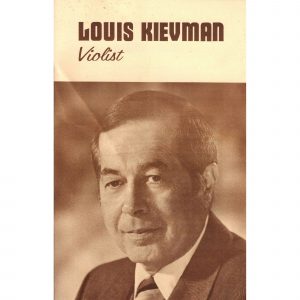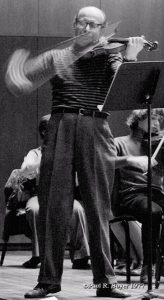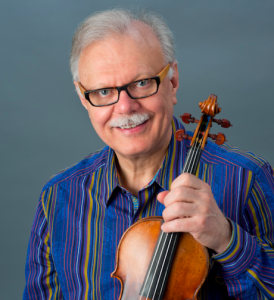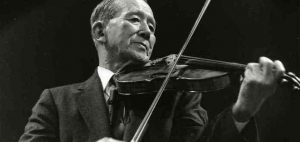Introductory Video: An Overview of Kievman, Rolland, Sassmannshaus, Suzuki Approaches Teaching Principles

Louis Kievman (1910-1990): Economy Approach
“One of the most common faults of beginning students is that they spend all of their bow on the short notes, and they are stingy with their long notes. The opposite is true. Use less than one inch of bow on the short notes and give more bow to the long notes.”
Major principles and concepts of the Economy approach:
- Emphasis on basics: every movement that goes into the performance of the skill dissected to its basic components and taught in its simplified form
- One of the goals of the approach is to get the most quality out of little practicing time (Kievman was student of Dounis.)
- “Bow is the instrument” & “The bridge is the palette where string players mix the colors and the bow hair is the artist’s brush” (Kievman paraphrased)
- Kievman wrote highly praised method books for violin and viola to be used in applied lessons. Additionally, he wrote method books consisting of twelve lessons to be used in heterogeneous string classes.

Paul Rolland (1911-1978): Movement in Action Approach
“Get them [string students] started right and aim them in right direction and they will reach the top…..students should use well coordinated movements without excessive tension as they play…..naturalness, naturalness, naturalness…….”
Major principles and concepts of the Movement in Action approach:
- Movement is the fundamental aspect of playing as one cannot produce the sound on string instruments without movement.
- All tensions in playing can be resolved through movement. He explored this idea in five areas of techniques: “movement and violin support”, “movement and bowing”, “movement in swing, pushed, and sustained strokes”, “movement and shifting”, and “movement and vibrato.”

Egon and Kurt’s Sassmannshaus: Sassmannshaus Tradition
“While prior knowledge is not a pre-requisite to using this method, this publication uses simple rhythms and intervals from early childhood programs and transfers them into small and easy steps to build up a basic violin technique.”
Major principles and concepts of the SassComparison Kievman, Rolland, Sassmanshaus, Suzuki PARTmannshaus Tradition approach:
- Singing integral to learning how to play instrument (at early stages of instruction)
- Among all beginning/intermediate approaches/methods this is the only one that provides words/notation for the songs to be learned as a preview to learning how to play same songs.
- Uses children folk songs in a manner similar to Kodaly’s method
- Only beginning/intermediate approach that provides exercises designed to “lift”/release the pressure in the left-hand fingers before shifting movement begins (i.e., lifting finger to the surface of the string to “harmonic” pressure)
- Three steps of shifting: “Lift-Slide-Drop”
- Beautifully illustrated method books available for all four string instruments along with supplemental materials.
- Approach can be used in private lessons and in small homogeneous group classes, but with method books being notated in different keys it is not suitable for use in heterogeneous classes.

Shinichi Suzuki (1898-1998): Song Method
“Do not hurry. This is a fundamental rule. If you hurry and collapse or tumble down, nothing is achieved. DO not rest in your efforts; this is another fundamental rule. Without stopping, without haste, carefully taking a step at a time forward will surely get you there.”
Major principles and concepts of Song Method:
- Three tenets of learning: early start, good method, and well-trained teacher
- Tone is expression of the life-force. Struggling for “better and good tone” encourages the development of good character.
- Rote learning should precede learning by note.
- Memorization is emphasized and it starts with daily listening.
- Standardized repertoire, organized in ten books, with pieces that gradually progress form simpler to more complex, allows students from around the world to play same repertoire and to play together when occasion arrises.
- Approach can be used in private lessons and in small homogenous group classes.
Lesson 2 Handout
Comparison Kievman, Rolland, Sassmanshaus, Suzuki
Course supplemental handout:
Comparison of Seven Ped Approaches Pedagogy Course TABLE